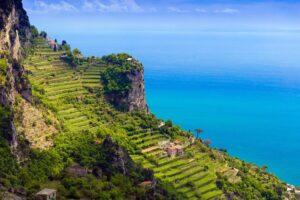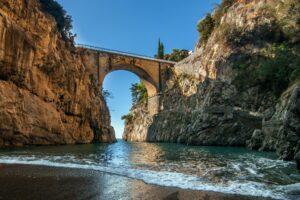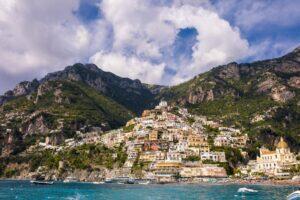Fodor's Expert Review Duomo di Sant'Andrea
Complicated, grand, delicate, and dominating, the 9th-century Amalfi cathedral has been remodeled over the years with Romanesque, Byzantine, Gothic, and Baroque elements but retains a predominantly Arab-Norman style. This intriguing blend of architectural styles easily confuses past and present, old and new, authentic and revival. The facade, with its glimmering mosaics, intricate patterns, and Arab design influences, is in fact no older than the 19th century. It was the master work of Neapolitan architect Errico Alvino, created during the height of Italy's fascination with Revivalism. The campanile, spliced with Saracen colors and intricate tile work, is the real deal and dates to the 13th century. The Chiostro del Paradiso (Paradise Cloister) is an Arab-Sicilian spectacular. Built around 1266 as a burial ground for Amalfi's elite, the cloister, the first stop on a tour of the cathedral, is one of southern Italy's architectural treasures. Its flower-and-palm-filled quadrangle has a... READ MORE
Complicated, grand, delicate, and dominating, the 9th-century Amalfi cathedral has been remodeled over the years with Romanesque, Byzantine, Gothic, and Baroque elements but retains a predominantly Arab-Norman style. This intriguing blend of architectural styles easily confuses past and present, old and new, authentic and revival. The facade, with its glimmering mosaics, intricate patterns, and Arab design influences, is in fact no older than the 19th century. It was the master work of Neapolitan architect Errico Alvino, created during the height of Italy's fascination with Revivalism. The campanile, spliced with Saracen colors and intricate tile work, is the real deal and dates to the 13th century. The Chiostro del Paradiso (Paradise Cloister) is an Arab-Sicilian spectacular. Built around 1266 as a burial ground for Amalfi's elite, the cloister, the first stop on a tour of the cathedral, is one of southern Italy's architectural treasures. Its flower-and-palm-filled quadrangle has a series of exceptionally delicate intertwining arches on slender double columns.
The chapel at the back of the cloister leads into the earlier (9th-century) basilica. Romanesque in style, the structure has a nave, two aisles, and a high, deep apse. Note the 14th-century crucifixion scene by a student of Giotto. This section has now been transformed into a museum, housing sarcophagi, sculpture, Neapolitan goldsmiths' artwork, and other treasures from the cathedral complex.
Steps from the basilica lead down into the Cripta di Sant'Andrea (Crypt of St. Andrew). The cathedral above was built in the 13th century to house the saint's bones, which came from Constantinople and supposedly exuded a miraculous liquid believers call the "manna of St. Andrew." Following the one-way traffic up to the cathedral itself, you finally get to admire the elaborate polychrome marbles and painted, coffered ceilings from its 18th-century restoration. Art historians shake their heads over this renovation, as the original decoration of the apse must have been one of the wonders of the Middle Ages.
READ LESS








